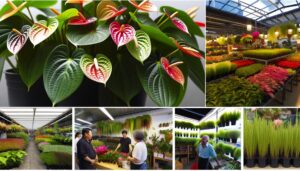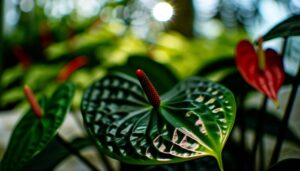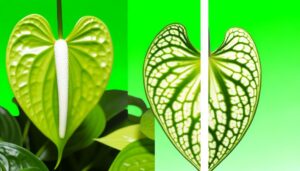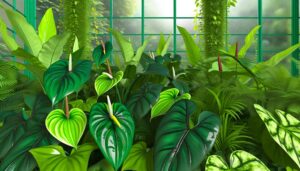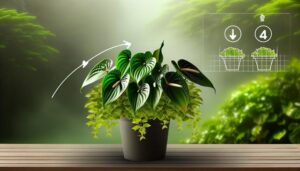What Makes Anthurium Forgetii Dark Form Unique? Discover!
The Anthurium forgetii dark form distinguishes itself through unique orbicular leaves that lack sinus and lobes, belonging to the Anthurium genus. Its foliage exhibits a dark, velvety texture due to anthocyanin pigmentation, offering significant tactile and visual appeal.
Well-defined venation patterns enhance its taxonomic importance. This plant thrives at 65-80°F (18-27°C) and requires a well-draining potting mix.
Ideal water, humidity, and nutrient regimens are critical for maintaining its distinctive characteristics. Propagation methods, such as stem cutting and air layering, are pivotal for sustaining its genetic fidelity.
Discover more nuances about this fascinating botanical specimen ahead.
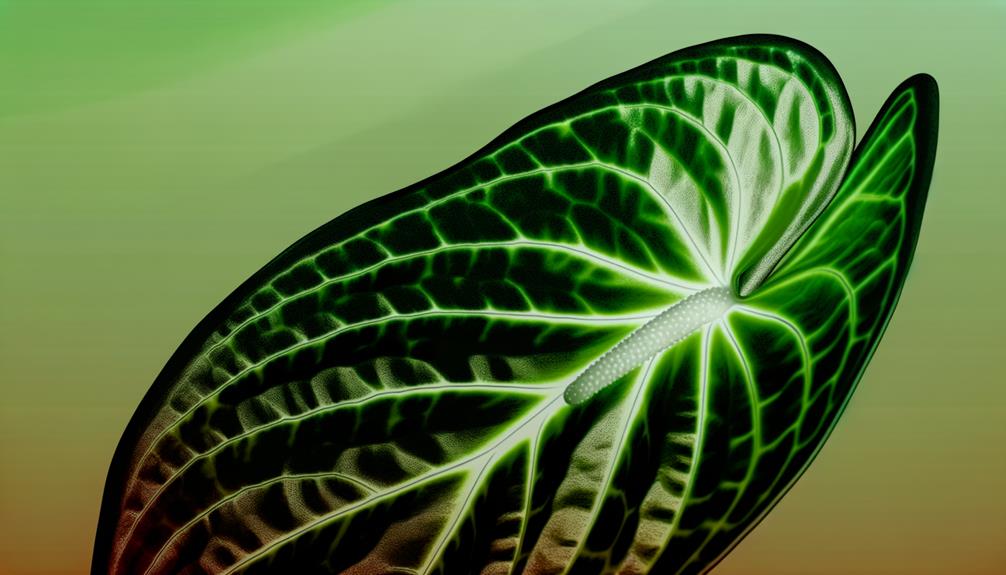
Key Takeaways
- The orbicular leaf shape without sinus and lobes distinguishes Anthurium Forgetii Dark Form.
- Its dark velvety foliage with rich deep green coloration is highly sought after by collectors.
- Unique trichomes on the leaves provide a soft tactile experience and protective adaptation.
- Anthocyanin pigmentation results in dynamic color variations and enhanced depth.
- Specific temperature preferences (65-80°F) are crucial for optimal growth and disease resistance.
Unique Leaf Shape

What distinguishes Anthurium Forgetii Dark Form is its unique, orbicular leaf shape, characterized by a lack of sinus and lobes, which diverges significantly from the typical morphology observed in other species within the Anthurium genus.
This distinctive leaf structure, classified under the section Cardiolonchium, displays a rounded, almost shield-like configuration, devoid of the usual lobed or heart-shaped features seen in related species.
The absence of sinus, a common characteristic in other Anthurium species, provides a continuous leaf margin that enhances its ornamental appeal.
Detailed examination reveals a well-defined venation pattern, contributing to its structural rigidity and aesthetic charm. This phenotypic variation underscores the taxonomic importance of A. Forgetii Dark Form within the diverse Anthurium genus.
Dark Velvety Foliage
The Anthurium forgetii dark form exhibits a remarkable dark velvety foliage, characterized by its rich, deep green coloration that notably enhances its visual appeal.
This species, belonging to the Araceae family, features an epidermal layer that provides a soft tactile experience, contributing to its exotic allure.
Detailed examination reveals a unique leaf texture that sets it apart from other Anthurium species, making it a sought-after specimen for collectors and botanists alike.
Rich Coloration Appeal
Characterized by its striking dark velvety foliage, Anthurium forgetii Dark Form boasts a rich coloration that enhances its ornamental value and distinguishes it within the Araceae family.
The deep, almost black-green hue of the leaves is a result of increased anthocyanin pigmentation, contributing to its unique aesthetic appeal. This coloration is not only visually arresting but also exhibits variations in different lighting conditions, showcasing a dynamic interplay of light and shadow.
Moreover, the absence of sinus and lobes—a hallmark of A. forgetii—combined with its velvety texture, accentuates the depth of color. Such features make it a highly sought-after species for both botanical enthusiasts and professional horticulturists, underscoring its distinctive place in plant collections.
Soft Touch Experience
One of the most notable tactile features of Anthurium forgetii Dark Form is its dark velvety foliage, which offers a uniquely soft touch experience, attributed to the presence of fine, microscopic trichomes on the leaf surface.
These trichomes, or tiny hair-like structures, are integral to the plant’s adaptive physiology, providing protection and reducing water loss. The trichomes create a velutinous texture, enhancing the leaf’s luxurious feel.
Additionally, the Anthurium genus, particularly the species forgetii, is renowned for such specialized epidermal structures. This morphological adaptation not only contributes to the plant’s aesthetic appeal but also plays a role in its ecological interactions by minimizing herbivory and optimizing microclimate conditions on the leaf surface.
Exotic Leaf Texture
Among the myriad of Anthurium species, Anthurium forgetii Dark Form stands out with its exotically dark, velvety foliage, a feature that is both visually striking and botanically significant.
The leaf surface exhibits a unique velvety texture due to its specialized epidermal cells and dense trichomes, which contribute to its deep, rich hue. This phenotypic characteristic enhances light absorption, optimizing photosynthetic efficiency in low-light environments, a trait advantageous for understory survival.
Taxonomically classified under the Araceae family, A. forgetii Dark Form’s foliage is devoid of sinus, distinguishing it from closely related species.
The pronounced velvety texture not only adds to its visual appeal but also provides a tactile experience, further accentuating its exotic allure and making it a coveted specimen among plant enthusiasts.
Prominent Silver Veins
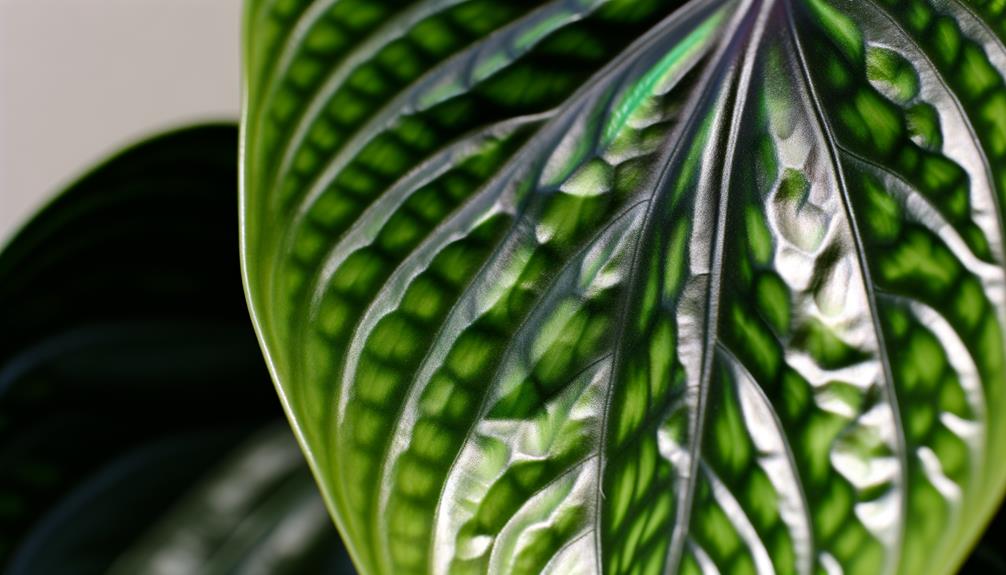
The Anthurium forgetii Dark Form is distinguished by its prominent silver veins, which provide a stark contrast against the deep green foliage, enhancing its unique aesthetic appeal. These veins are a critical morphological feature in identifying this cultivar within the Araceae family. The silver venation not only adds to its visual allure but also serves as a diagnostic characteristic for taxonomic classification.
Key observations include:
- Vein Prominence: The silver veins are markedly pronounced, making them easily noticeable even from a distance.
- Contrasting Coloration: The juxtaposition of silver veins against dark green leaves creates a striking visual effect.
- Growth Pattern: Veins follow a consistent, symmetrical pattern, contributing to the plant’s overall symmetry.
- Reflective Properties: The veins exhibit a slight metallic sheen, enhancing light reflection and visibility.
Understanding these traits aids in appreciating the plant’s botanical uniqueness.
Compact Growth Habit
In addition to its striking silver venation, the Anthurium forgetii Dark Form exhibits a compact growth habit, characterized by tightly clustered foliage and minimal internodal spacing.
This morphological trait results in a dense, bush-like appearance, which is particularly appealing in ornamental horticulture.
The compact growth habit is an adaptive feature that maximizes light capture and reduces transpiration, enhancing the plant’s resilience in various microhabitats.
| Characteristic | Description |
|---|---|
| Leaf Arrangement | Tightly clustered |
| Internodal Spacing | Minimal |
| Growth Form | Dense and bush-like |
| Adaptation Benefits | Enhanced light capture, reduced transpiration |
These attributes, combined with the plant’s aesthetic appeal, make Anthurium forgetii Dark Form a desirable specimen for botanical collections and interior landscaping.
Indoor Care Requirements

How can one ensure optimal indoor care for Anthurium forgetii Dark Form, given its unique physiological and morphological characteristics? Understanding the plant’s intrinsic needs is critical.
This species thrives in environments that mimic its native tropical habitat. To achieve the best growth, consider the following key factors:
- Light Requirements: Provide bright, indirect sunlight to prevent leaf scorch while promoting photosynthesis.
- Soil Composition: Utilize a well-draining, aerated medium rich in organic matter to support root health and prevent waterlogging.
- Watering Regimen: Maintain consistent soil moisture, avoiding both desiccation and oversaturation.
- Temperature Range: Maintain ambient temperatures between 65-80°F (18-27°C), avoiding sudden fluctuations.
Adhering to these guidelines will promote a thriving Anthurium forgetii Dark Form, reflecting its natural ecological conditions.
Ideal Humidity Levels
Achieving peak growth for Anthurium forgetii Dark Form requires maintaining high humidity levels, ideally between 70-85%, to replicate its native tropical microclimate. These humidity levels are crucial for the best physiological processes, including transpiration and nutrient uptake.
Anthurium forgetii, a member of the Araceae family, shows epiphytic adaptations, thriving in environments with consistent atmospheric moisture. Inadequate humidity can lead to reduced turgor pressure, resulting in desiccation of foliar structures and less than ideal growth. Observations suggest that maintaining this specific humidity range supports the development of the plant’s distinctive, velvety foliage and enhances its phenotypic coloration.
Humidity levels below 60% may trigger stress responses, compromising the plant’s overall health and vigor. Therefore, regular monitoring and humidification strategies are crucial for cultivating this unique Anthurium taxa.
Temperature Preferences

Maintaining ideal temperature ranges is equally significant for Anthurium forgetii Dark Form, with preferred ambient temperatures between 65-80°F (18-27°C) to support its metabolic and physiological functions. Deviations from these peak conditions can adversely affect the plant’s growth and overall health.
Key observations include:
- Thermal Stress: Prolonged exposure to temperatures below 60°F (15°C) or above 85°F (29°C) can induce thermal stress, leading to chlorosis or necrosis.
- Growth Rate: Peak temperatures facilitate robust growth and development, while subpar temperatures can stifle cellular processes.
- Respiration and Photosynthesis: Temperature fluctuations influence the rates of respiration and photosynthesis, critical for energy production.
- Disease Resistance: Maintaining the recommended temperature range enhances the plant’s resistance to pathogenic microorganisms, promoting longevity.
Soil and Potting Mix
A well-draining, aerated potting mix enriched with organic matter is essential for the best growth of Anthurium forgetii Dark Form, providing necessary nutrients and preventing root rot.
This epiphytic species thrives in a substrate mimicking its natural habitat, typically a blend of orchid bark, charcoal, and perlite, which guarantees optimal aeration and drainage. Incorporating sphagnum moss can enhance moisture retention while maintaining adequate air flow around the roots.
Soil pH should be slightly acidic to neutral (pH 5.5-6.5), encouraging nutrient uptake. Frequent substrate evaluation is advisable to prevent compaction and ensure sustained porosity.
Additionally, a periodic top-dressing with compost or a balanced slow-release fertilizer can support the plant’s nutritional requirements, fostering robust growth and vibrant foliage.
Watering Needs

Proper hydration of Anthurium forgetii Dark Form is essential, necessitating a balance between moisture availability and prevention of waterlogging to sustain its epiphytic growth habit. Observations indicate that an optimal watering regime is essential for maintaining its unique foliar aesthetics and overall health.
To achieve this, consider the following guidelines:
- Frequency: Water approximately once per week, adjusting based on environmental conditions and potting medium’s drying rate.
- Water Quality: Utilize dechlorinated or distilled water to avoid mineral buildup, which can impact root health.
- Humidity: Maintain ambient humidity levels between 60-80% to mimic the plant’s native tropical atmosphere.
- Drainage: Ensure the potting mix provides excellent drainage to prevent root rot, a common issue in improperly hydrated epiphytes.
This approach will support the Anthurium forgetii Dark Form’s distinctive characteristics.
Fertilization Tips
Effective fertilization of Anthurium forgetii Dark Form requires a precise nutrient regimen to support its distinctive foliage and overall wellness. This species, belonging to the Araceae family, benefits from a balanced, water-soluble fertilizer with an N-P-K ratio of 20-20-20, applied bi-monthly during the growing season.
Micronutrients such as magnesium (Mg) and iron (Fe) are essential for chlorophyll synthesis and pigmentation, enhancing the plant’s dark, velvety leaves. Avoid over-fertilization, which may lead to root burn and reduced health. Dilute the fertilizer to half the recommended strength to prevent nutrient accumulation in the substrate.
Additionally, periodic leaching of the soil can mitigate salt build-up, ensuring ideal root health and sustained growth for this unique Anthurium variant.
Propagation Methods
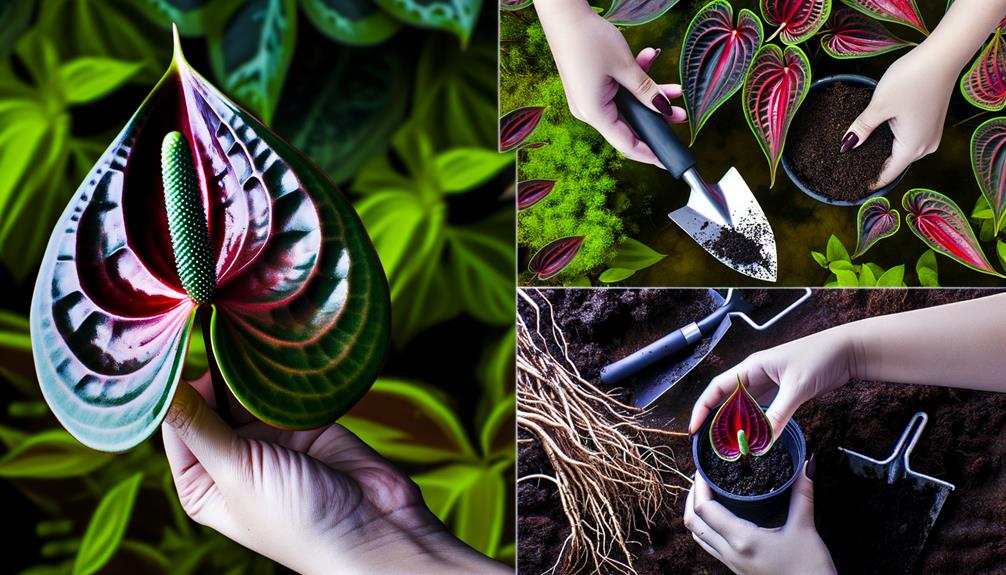
Propagation of Anthurium forgetii ‘Dark Form’ can be effectively achieved through several methodologies. These include stem cutting, air layering, and seed germination. Each technique necessitates specific conditions to optimize success rates and guarantee the preservation of phenotypic traits.
This section will provide a detailed examination of these propagation strategies, emphasizing their procedural nuances and biological implications.
Stem Cutting Technique
Initiating the stem cutting technique for Anthurium forgetii Dark Form involves selecting a healthy, mature stem with at least one node and a few aerial roots. This method ensures genetic fidelity and robust growth.
The steps are as follows:
- Selection and Cutting: Use sterilized pruning shears to excise a 6-8 inch stem segment with a node and aerial roots.
- Hormonal Treatment: Dip the cut end in rooting hormone to stimulate root development.
- Planting Medium: Insert the treated end into a well-draining substrate, such as a mixture of perlite and sphagnum moss.
- Environment Control: Maintain high humidity and indirect light conditions to promote root formation and acclimatization.
This method, grounded in empirical horticultural practices, maximizes propagation success for Anthurium forgetii Dark Form.
Air Layering Process
Air layering is a sophisticated vegetative propagation technique that is particularly advantageous for Anthurium forgetii Dark Form. It allows for the production of well-established, independent plants while still attached to the parent specimen. The method involves making a precise incision on the stem of Anthurium forgetii, exposing the vascular cambium without severing it entirely. The incision is then enveloped with moist sphagnum moss and covered with plastic to retain humidity. Over subsequent weeks, adventitious roots develop at the incision site. This process ensures that the new plantlet has an established root system before detachment, enhancing survival rates.
The scientific robustness of air layering makes it an excellent choice for maintaining the genetic fidelity and distinctive phenotypic attributes of Anthurium forgetii Dark Form.
Seed Germination Tips
Successfully germinating Anthurium forgetii Dark Form seeds requires careful attention to specific environmental conditions, including ideal humidity levels, temperature, and light exposure. To maximize germination success, follow these guidelines:
- Humidity: Maintain a relative humidity around 80-90%, utilizing a humidity dome or a closed terrarium to ensure consistent moisture levels.
- Temperature: Keep the ambient temperature between 25-28°C (77-82°F), as Anthurium seeds exhibit peak germination rates within this thermic range.
- Light Exposure: Provide indirect, diffused light to replicate the understory conditions of their native tropical habitats, avoiding direct sunlight to prevent seed desiccation.
- Substrate: Utilize a well-aerated, sterile germination medium, such as a mix of sphagnum moss and perlite, to facilitate proper drainage and reduce pathogen pressure.
These parameters collectively improve the germination viability of Anthurium forgetii Dark Form seeds.
Conclusion
To sum up, Anthurium forgetii dark form exhibits an extraordinary combination of unique leaf morphology, dark velvety foliage, and prominent silver veins, coinciding to create a visually striking specimen.
Its compact growth habit and specific indoor care requirements, including precise soil composition, watering regimens, and fertilization practices, make it a compelling subject for botanical study.
Propagation methods further underscore its distinctiveness within the genus Anthurium, highlighting its exceptional adaptability and allure in controlled environments.

